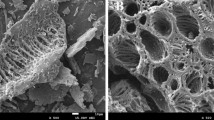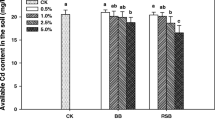Abstract
As a carbon-negative emission technology, biochar has attracted extensive attention for application in fields for soil improvement and pollution control. The interactions between biochar and soil cadmium via the coupling of physical and chemical processes with extensive application and the correlation between the speciation of soil heavy metals and bioavailability are current research hotspots. However, the effect of biochar on Cd immobilization in soil and its transfer to purslanes have seldom been addressed. Thus, this study sought to determine the effects of wheat straw biochar on purslane biomass and Cd distribution in soil and purslane. Biochar application was found to increase purslane gross biomass, especially its stem, by 27.52–43.26% (root and aboveground parts) relative to the control. Biochar application also significantly decreased Cd levels by 10.88–46.04% and 14.07–35.30% in purslane shoots and roots; this effect was enhanced by the increase in biochar application rate. Biochar application increased soil pH by 0.33–0.90 and soil organic carbon (SOC) by 157.28–553.50%, markedly contributing to Cd immobilization in the soil. The soil available Cd concentration decreased by 2.19% and 15.89% with biochar application. The functional groups of biochar have also been shown to facilitate Cd complexation, which contributes to the immobilization and stabilization of soil Cd.





Similar content being viewed by others
Data Availability
The datasets generated during and/or analyzed in the current study are available from the corresponding author on reasonable request.
References
Albert, H. A., Li, X., Jeyakumar, P., Wei, L., Huang, L. X., Huang, Q., Kamran, M., Shaheen, S. M., Hou, D. Y., Rinklebe, J., Liu, Z. Z., Wang, H. L. (2021). Influence of biochar and soil properties on soil and plant tissue concentrations of Cd and Pb: A meta-analysis. Science of the Total Environment, 755, 142582.
Ashrafi, A., Zahedi, M., & Soleimani, M. (2015). Effect of co-planted purslane (Portulaca Oleracea L.) on Cd accumulation by sunflower in different levels of Cd contamination and salinity: A pot study. International Journal of Phytoremediation, 17(9), 853–60.
Bashir, S., Hussain, Q., Shaaban, M., & Hu, H. (2018). Efficiency and surface characterization of different plant derived biochar for cadmium (Cd) mobility, bioaccessibility and bioavailability to Chinese cabbage in highly contaminated soil. Chemosphere, 211, 632–639.
Beesley, L., Moreno-Jiménez, E., Gomez-Eyles, J. L., Harris, E., Robinson, B., & Sizmur, T. (2011). A review of biochars’ potential role in the remediation, revegetation and restoration of contaminated soils. Environmental Pollution, 159(12), 3269–3282.
Bis, Z., Kobyłecki, R., Ścisłowska, M., & Zarzycki, R. (2018). Biochar – Potential tool to combat climate change and drought. Ecohydrology & Hydrobiology, 18(4), 441–453.
Cao, X., Ma, L., Gao, B., & Harris, W. (2009). Dairy-manure derived biochar effectively sorbs lead and atrazine. Environmental Science and Technology, 43(9), 3285–3291.
Cui, L., Ippolito, J. A., Noerpel, M., Scheckel, K. G., & Yan, J. (2021). Nutrient alterations following biochar application to a Cd-contaminated solution and soil. Biochar, 3, 457–468.
Cui, L., Li, L., Zhang, A., Pan, G., Bao, D., & Chang, A. (2011). Biochar amendment greatly reduces rice cd uptake in a contaminated paddy soil: A two-year field experiment. BioResources, 6(3), 2605–2618.
Cui, L., Noerpel, M. R., Scheckel, K. G., & Ippolito, J. A. (2019). Wheat straw biochar reduces environmental cadmium bioavailability. Environment International, 126, 69–75.
Cui, L., Pan, G., Li, L., Bian, R., Liu, X., Yan, J., Quan, G., Ding, C., Chen, T., Liu, Y., Liu, Y., Yin, C., Wei, C., Yang, Y., & Hussain, Q. (2016). Continuous immobilization of cadmium and lead in biochar amended contaminated paddy soil: A five-year field experiment. Ecological Engineering, 93, 1–8.
Cui, L., Pan, G., Li, L., Yan, J., Zhang, A., Bian, R., & Chang, A. (2012). The reduction of wheat cd uptake in contaminated soil via biochar amendment: A two-year field experiment. BioResources, 7(4), 5666–5676.
Cui, L., Yan, J., Li, L., Quan, G., Ding, C., Chen, T., Yin, C., Gao, J., & Hussain, Q. (2015). Does biochar alter the speciation of Cd and Pb in aqueous solution? BioResources, 10(1), 88–104.
Cui, L., Yin, C., Chen, T., Quan, G., Ippolito, J. A., Liu, B., Yan, J., Ding, C., Hussain, Q., & Umer, M. (2019). Remediation of organic halogen- contaminated wetland soils using biochar. Science of the Total Environment, 696, 134087.
Fan, Q., Cui, L., Quan, G., Wang, S., Sun, J., Han, X., Wang, J., Yan, J. (2018a). Effects of wet oxidation process on biochar surface in acid and alkaline soil environments. Materials, 11(12), 2362.
Fan, Q., Sun, J., Chu, L., Cui, L., Quan, G., Yan, J., Hussain, Q., & Iqbal, M. (2018b). Effects of chemical oxidation on surface oxygen-containing functional groups and adsorption behavior of biochar. Chemosphere, 207, 33–40.
Hu, S., Zhang, D., Yang, Y., Ran, Y., Mao, J., Chu, W., & Cao, X. (2019). Effects of the chemical structure, surface, and micropore properties of activated and oxidized black carbon on the sorption and desorption of phenanthrene. Environmental Science & Technology, 53(13), 7683–7693.
Khan, A. Z., Khan, S., Khan, M. A., Alam, M., & Ayaz, T. (2020). Biochar reduced the uptake of toxic heavy metals and their associated health risk via rice (Oryza sativa L.) grown in Cr-Mn mine contaminated soils. Environmental Technology & Innovation, 17, 100590.
Levizou, E., Antoniadis, V., & Papatheodorou, S. (2016). Without exceeding the limits: Industrial soil rich in Zn and Cd has no effect on purslane and lettuce but promotes geranium growth. Environmental Earth Sciences, 75(18), 1256.
Li, D., Lai, C., Li, Y., Li, H., Chen, G., Lu, Q. (2021). Biochar improves cd-contaminated soil and lowers Cd accumulation in Chinese flowering cabbage (Brassica parachinensis L.). Soil & Tillage Research, 213, 105085.
Liu, G., Meng, J., Huang, Y., Dai, Z., Tang, C., & Xu, J. (2020). Effects of carbide slag, lodestone and biochar on the immobilization, plant uptake and translocation of As and Cd in a contaminated paddy soil. Environmental Pollution, 266, 115194.
Liu, Y., Luo, H., Tie, B., Li, D., Liu, S., Lei, M., & Du, H. (2021). The long-term effectiveness of ferromanganese biochar in soil Cd stabilization and reduction of Cd bioaccumulation in rice. Biochar, 3(4), 499–509.
Lu, R. (2000). Methods of inorganic pollutants analysis. In Soil and agro-chemical analysis methods (pp. 205–266). China Agriculture Science and Technique Press.
Novak, J. M., Ippolito, J. A., Watts, D. W., Sigua, G. C., Ducey, T. F., & Johnson, M. G. (2019). Biochar compost blends facilitate switchgrass growth in mine soils by reducing Cd and Zn bioavailability. Biochar, 1(1), 97–114.
Osma, E., Ozyigit, I. I., Demir, G., & Yasar, U. (2014). Assesment of some heavy metals in wild type and cultivated purslane (portulaca oleracea l.) and soils in istanbul, turkey. Fresenius Environmental Bulletin, 23(9), 2181–2189.
Rees, F., Germain, C., Sterckeman, T., & Morel, J.-L. (2015). Plant growth and metal uptake by a non-hyperaccumulating species (Lolium perenne) and a Cd-Zn hyperaccumulator (Noccaea caerulescens) in contaminated soils amended with biochar. Plant and Soil, 395(1), 57–73.
Rehman, M. Z., Batool, Z., Ayub, M. A., Hussaini, K. M., Murtaza, G., Usman, M., Naeem, A., Khalid, H., Rizwan, M., & Ali, S. (2020). Effect of acidified biochar on bioaccumulation of cadmium (Cd) and rice growth in contaminated soil. Environmental Technology & Innovation, 19, 101015.
Rizwan, M., Ali, S., Qayyum, M. F., Ibrahim, M., Zia-ur-Rehman, M., Abbas, T., & Ok, Y. S. (2016). Mechanisms of biochar-mediated alleviation of toxicity of trace elements in plants: A critical review. Environmental Science and Pollution Research International, 23(3), 2230–2248.
Seif, M. M., Madboli, A.-N., Marrez, D. A., & Aboulthana, W. M. K. (2019). Hepato-renal protective effects of Egyptian purslane extract against experimental cadmium toxicity in rats with special emphasis on the functional and histopathological changes. Toxicology Reports, 6, 625–631.
Sun, X., Zhong, T., Zhang, L., Zhang, K., & Wu, W. (2019). Reducing ammonia volatilization from paddy field with rice straw derived biochar. Science of the Total Environment, 660, 512–518.
Tang, B., Xu, H. P., Song, F. M., Ge, H. G., Chen, L., Yue, S. Y., & Yang, W. S. (2022). Effect of biochar on immobilization remediation of Cd center dot contaminated soil and environmental quality. Environmental Research, 204, 111840.
Tang, J., Zhang, L., Zhang, J., Ren, L., Zhou, Y., Zheng, Y., Luo, L., Yang, Y., Huang, H., & Chen, A. (2020). Physicochemical features, metal availability and enzyme activity in heavy metal-polluted soil remediated by biochar and compost. Science of the Total Environment, 701, 134751.
Tian, X., Ding, Y., Kong, Y., Wang, G., Wang, S., & Cheng, D. (2021). Purslane (Portulacae oleracea L) attenuates cadmium-induced hepatorenal and colonic damage in mice: Role of chelation, antioxidant and intestinal microecological regulation. Phytomedicine : International Journal of Phytotherapy and Phytopharmacology, 92, 153716.
Wang, Y., Liu, C., Zhou, D., & Chen, H. (2014). A critical view on the status quo of the farmland soil environmental quality in China: Discussion and suggestion of relevant issues on report on the national gengeal survey of soil contamination. Journal of Agro-Environment Science, 33(8), 1465–1473.
Xing, J., Li, L., Li, G., & Xu, G. (2019). Feasibility of sludge-based biochar for soil remediation: Characteristics and safety performance of heavy metals influenced by pyrolysis temperatures. Ecotoxicology and Environmental Safety, 180, 457–465.
Yaghoubian, Y., Siadat, S. A., Moradi Telavat, M. R., & Pirdashti, H. (2016). Quantify the response of purslane plant growth, photosynthesis pigments and photosystem II photochemistry to cadmium concentration gradients in the soil. Russian Journal of Plant Physiology, 63(1), 77–84.
Yousaf, B., Liu, G., Wang, R., Zia-ur-Rehman, M., Rizwan, M. S., Imtiaz, M., Murtaza, G., & Shakoor, A. (2016). Investigating the potential influence of biochar and traditional organic amendments on the bioavailability and transfer of Cd in the soil–plant system. Environmental Earth Sciences, 75(5), 374.
Yuan, J. H., Xu, R. K., & Zhang, H. (2011). The forms of alkalis in the biochar produced from crop residues at different temperatures. Bioresource Technology, 102(3), 3488–3497.
Zanganeh, F., Heidari, A., Sepehr, A., & Rohani, A. (2022). Bioaugmentation and bioaugmentation–assisted phytoremediation of heavy metal contaminated soil by a synergistic effect of cyanobacteria inoculation, biochar, and purslane (Portulaca oleracea L.). Environmental Science and Pollution Research, 29, 6040–6059.
Zhang, M., Wang, X., Hao, H., Wang, H., Duan, L., & Li, Y. (2019). Formation of disinfection byproducts as affected by biochar during water treatment. Chemosphere, 233, 190–197.
Zhang, X., Zhang, Y., Liu, X., Zhang, C., Dong, S., Liu, Q., & Deng, M. (2020). Cd uptake by Phytolacca americana L. promoted by cornstalk biochar amendments in Cd-contaminated soil. International Journal of Phytoremediation, 22(3), 251–258.
Acknowledgements
The authors are indebted to the Yancheng Institute of Technology Analysis and Testing Center for access to the FTIR facility.
Funding
This study was financially supported by the National Natural Science Foundation of China (21677119).
Author information
Authors and Affiliations
Contributions
Xiangyun Han: investigation, data curation, writing, and revision.
Liqiang Cui: methodology and writing—original draft.
Jinlong Yan: revision.
Corresponding author
Ethics declarations
Conflict of Interest
The authors declare no competing interests.
Additional information
Publisher's Note
Springer Nature remains neutral with regard to jurisdictional claims in published maps and institutional affiliations.
Rights and permissions
Springer Nature or its licensor (e.g. a society or other partner) holds exclusive rights to this article under a publishing agreement with the author(s) or other rightsholder(s); author self-archiving of the accepted manuscript version of this article is solely governed by the terms of such publishing agreement and applicable law.
About this article
Cite this article
Han, X., Cui, L. & Yan, J. Effects of Biochar on Purslane-Mediated Transfer and Uptake of Soil Bioavailable Cadmium. Water Air Soil Pollut 233, 479 (2022). https://doi.org/10.1007/s11270-022-05952-8
Received:
Accepted:
Published:
DOI: https://doi.org/10.1007/s11270-022-05952-8




